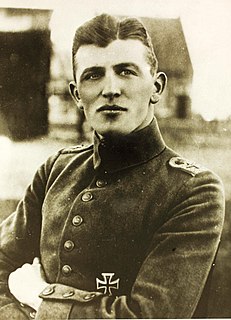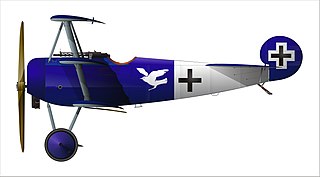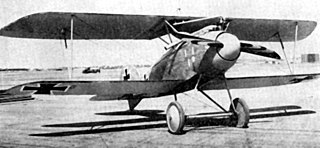Early military career

Hans Goerth initially served in Kusta III. He was then with Marine Feld Jasta I from 26 February 1918 until 21 June 1918, after which he transferred to Marine Feld Jasta III, which was formed that month. He remained in Marine Feld Jasta III until the end of the war. [1] [2] [3] [4] Goerth was credited with seven aerial victories. [1] [5] [6] Marine Feld Jasta III, established at the Jabbeke aerodrome on 23 June 1918, was commanded by Leutnant der Reserve der Matrosenartillerie (MA-naval artillery) Gustav Brockhoff, who had at least four confirmed victories during World War I. MFJ III remained at Jabbeke airfield, also referred to as Varsenare or Snellegem, until retreat in early October 1918. [1] [6] [7] With seven confirmed victories, Hans Goerth was the top ace of MFJ III. [7] [8]

Goerth earned his first two victories while flying an Albatros D.Va with serial number 7167/18. [1] The first plane, Airco de Havilland DH.4 (A8013), was shot down over Mariakerke, Belgium on 30 June 1918. [5] Lieutenant Clifford James Moir and Serjeant Mechanic Edwin Edward Hunnisett, both of No. 217 Squadron of the Royal Air Force died in that conflict. [9] [10] [11] Goerth's second victory was an Airco DH.9 that was taken down over Nieuwpoort, West Flanders, Belgium on 7 July 1918. [1] [5] Lieutenant J. R. Harington and Second Lieutenant Cyril Ivor Bray were the aviators in the DH.9. [2] [3] Both men from No. 206 Squadron of the Royal Air Force were buried in adjacent graves at Anzac Cemetery in Sailly-sur-la-Lys, Pas-de-Calais, France. [12]
On 16 July 1918, over Zevekote, West Flanders, Belgium, Goerth shot down DH.4 (A7868) piloted by British flying ace Lieutenant Lionel Arthur Ashfield of the No. 202 Squadron of the 61st wing of the Royal Air Force. [1] [5] [13] [14] That combat triumph also claimed the life of Irish Lieutenant Maurice Graham English. [6] [15] [16] Goerth's fourth victory took place west of Handzame, West Flanders on 30 August 1918, when he shot down Sopwith Camel (D9482) of the No. 65 Squadron of the Royal Air Force from his Fokker D.VII (Albatros) with serial number 838/18. [1] [5] The aviator in the Camel was Second Lieutenant Henry George Pike. He died in the encounter and is represented on the Arras Flying Services Memorial at the Faubourg d'Amiens Cemetery. [2] [3] [17] [18] Pike is also commemorated at Wandsworth Cemetery in Wandsworth, Greater London, England. [19]

Goerth's remaining victories were from D.VII aircraft as well. On 16 September, Goerth shot down Sopwith Camel (B7271) over Zerkegem, West Flanders. [5] Second Lieutenant Edward Burleigh Markquick of the No. 210 Squadron died in that confrontation and is commemorated on the Arras Flying Services Memorial. [2] [3] [20] Goerth's final two victories (sixth and seventh) both occurred on 1 October 1918. [1] [5] During aerial combat, he first shot down a DH.9 from No. 108 Squadron south of Houthulst, West Flanders and, twenty-five minutes later, a Sopwith Camel from No. 210 Squadron south of Handzame. [1] [2] [3] [5] That day Goerth was piloting a Fokker D.VII marked with a black heart on a white band. [1] Hans Goerth received the Landfliegerabzeichen on 22 May 1918 and the Ehrenrpreis on 28 July 1918. [4] The ace was promoted to Vizeflugmeister in September 1918 and he was the recipient of the Iron Cross First Class. [2] [3]










